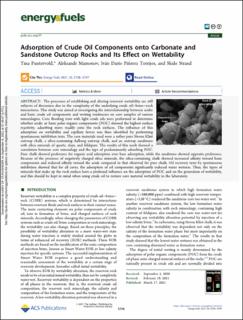| dc.contributor.author | Puntervold, Tina | |
| dc.contributor.author | Mamonov, Aleksandr | |
| dc.contributor.author | Piñerez Torrijos, Iván Darío | |
| dc.contributor.author | Strand, Skule | |
| dc.date.accessioned | 2021-11-08T14:33:40Z | |
| dc.date.available | 2021-11-08T14:33:40Z | |
| dc.date.created | 2021-09-07T14:11:03Z | |
| dc.date.issued | 2021-03 | |
| dc.identifier.citation | Puntervold, T., Mamonov, A., Piñerez Torrijos, I,D. (2021) Adsorption of Crude Oil Components onto Carbonate and Sandstone Outcrop Rocks and Its Effect on Wettability. Energy & Fuels, 35 (7), 5738-5747. | en_US |
| dc.identifier.issn | 0887-0624 | |
| dc.identifier.uri | https://hdl.handle.net/11250/2828433 | |
| dc.description.abstract | The processes of establishing and altering reservoir wettability are still subjects of discussion due to the complexity of the underlying crude oil–brine–rock interactions. This study was aimed at investigating the interrelationship between acidic and basic crude oil components and wetting tendencies on core samples of various mineralogies. Core flooding tests with light crude oils were performed to determine whether acidic or basic polar organic components (POC) showed the highest surface reactivity, adsorbing more readily onto the rock surfaces. The influence of this adsorption on wettability and capillary forces was then identified by performing spontaneous imbibition tests. The core materials used were a rather pure Stevns Klint outcrop chalk, a silica-containing Aalborg outcrop chalk, and an outcrop sandstone with silica minerals of quartz, clays, and feldspars. The results of this work showed a correlation between core mineralogy and the type of predominantly adsorbing POC. Pure chalk showed preference for organic acid adsorption over base adsorption, while the sandstone showed opposite preference. Because of the presence of negatively charged silica minerals, the silica-containing chalk showed increased affinity toward basic components and reduced affinity toward the acids compared to that observed for pure chalk. Oil recovery tests by spontaneous imbibition showed that for all cores, the adsorption of oil components significantly reduced water wetness. Thus, the types of minerals that make up the rock surface have a profound influence on the adsorption of POC and on the generation of wettability, and this should be kept in mind when using crude oil to restore core material wettability in the laboratory. | en_US |
| dc.language.iso | eng | en_US |
| dc.publisher | American Chemical Society | en_US |
| dc.rights | Navngivelse 4.0 Internasjonal | * |
| dc.rights.uri | http://creativecommons.org/licenses/by/4.0/deed.no | * |
| dc.subject | råolje | en_US |
| dc.subject | petroleumsteknologi | en_US |
| dc.subject | petrokjemikalier | en_US |
| dc.subject | adsorpsjon | en_US |
| dc.title | Adsorption of Crude Oil Components onto Carbonate and Sandstone Outcrop Rocks and Its Effect on Wettability | en_US |
| dc.type | Peer reviewed | en_US |
| dc.type | Journal article | en_US |
| dc.description.version | publishedVersion | en_US |
| dc.rights.holder | © 2021 The Authors | en_US |
| dc.subject.nsi | VDP::Teknologi: 500::Berg‑ og petroleumsfag: 510::Petroleumsteknologi: 512 | en_US |
| dc.source.pagenumber | 5738-5747 | en_US |
| dc.source.volume | 35 | en_US |
| dc.source.journal | Energy & Fuels | en_US |
| dc.source.issue | 7 | en_US |
| dc.identifier.doi | 10.1021/acs.energyfuels.0c03003 | |
| dc.identifier.cristin | 1932087 | |
| cristin.ispublished | true | |
| cristin.fulltext | original | |
| cristin.qualitycode | 2 | |

